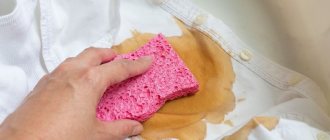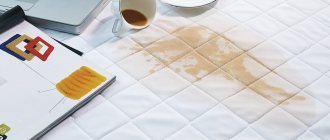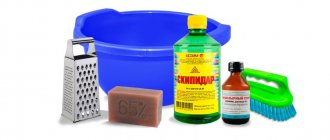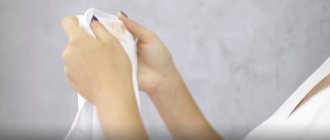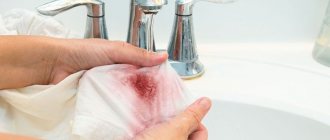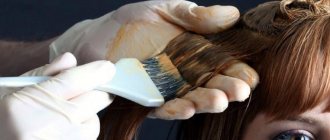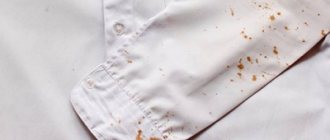- For natural fabrics
- For old stains
- For silk and wool
- Kitchen method
- For stubborn stains
- Method with glycerin
- How to remove coffee from white clothes
- For sofa or carpet
- For synthetic fabrics
- How to wash coffee from jeans
- Leather Products
- Shedding fabrics
- How to remove coffee from colored clothes
- Removing coffee and milk stains
What's a morning without coffee! But even the best morning can be ruined by a coffee stain. And this is not a speck of fat, which can be almost invisible on some things, but a dark dot in the most inappropriate place. The worst thing is if you have light, monochromatic clothes, because then you can’t tell that it’s part of the design. How and with what to remove coffee stains?
For natural fabrics
Linen and cotton are highly absorbent, so you need to wash these items as soon as possible. If you decide to walk with the stain all day, it is not a fact that you will then be able to wash coffee off cotton. But at the same time, cleaning this fabric is quite simple: soap the stained area and wash it. Repeat this procedure until you get the result. If you have a plain white item, you can try boiling it - this will help remove any remaining dirt from the fabric. But if you have a colored item, then forget about hot water, as the items will simply fade.
What you should pay attention to
If you accidentally spill coffee on your clothes and don't know if it can be washed out, don't panic. Drink stains, especially if they are fresh, can be easily removed from both white and dyed items. It is important to remember what you should never do:
- Wipe the stain with a napkin. From such actions, the contamination will penetrate deep into the fibers of the material, from where it will no longer be possible to remove it. You need to blot it with a napkin so that it absorbs the liquid, but do not rub it;
- Rinse the fabric with hot water. This way you can not only fix the contamination. Some materials, especially natural wool and synthetics, do not withstand contact with hot water, irreversibly changing their properties;
- Use aggressive detergents. Removing a stain can ruin painted items;
- Use bleaches. As a last resort, use bleach for colored fabrics by applying it to the stained area and then washing the entire item. There are several proven and fairly simple methods for cleaning fabrics from spilled coffee stains. When applying any of these, use a soft brush, not a cloth. And you shouldn’t rub the material too hard when washing.
For silk and wool
Silk and wool must first be washed with a cloth soaked in a soap and ammonia solution and only then washed. For the solution, you will need any soap (ideally laundry soap, as it works best with stains) and a little ammonia (3-5 tsp of ammonia will be enough for 1 liter of water). After cleaning, wash the item as usual.
Also try another folk method - mix alcohol, water and ammonia and wipe the fabric with this solution.
The wool can be cleaned with a swab soaked in gasoline and rinsed with a mixture of ammonia and water. Be sure to wash your items thoroughly, otherwise they will continue to smell like petroleum products.
Ammonia
From it you can prepare a solution that copes well with this kind of pollution. Add about 12 drops of alcohol to a volume of cold water of 0.5 liters and mix. Then soak a cotton pad, cotton cloth or brush in the resulting solution.
Using these items, the solution is applied to the jeans and gently wiped until the stain disappears. To avoid smearing and increasing the area of contamination, during the cleaning process it is recommended to move from the edges of the stain to the center. Then, the jeans can be washed in a regular automatic machine.
How to wash coffee from jeans
Since we need to remove coffee stains from jeans, take oxalic and citric acid, ammonia and stain remover with you. There are 2 effective ways to clean fabric:
- Mix 10 drops of ammonia and 0.5 liters of water and pour on the stain. After washing, it will be enough to simply rinse the clothes.
- Just pour a little citric or oxalic acid onto the stain, leave for about 1-1.5 hours and rinse. There is no need to increase the time, otherwise you will have “fashionable jeans” with stains.
Vinegar
- Mix 50 gr. washing powder, 15 gr. baking soda, pour vinegar solution (6%) to obtain a semi-dry mass. Add ice-cold purified water, bringing the mixture to a paste. Rub the coffee stain with an ice cube on both sides, apply the prepared product in a thick layer, and leave for 5 minutes. At the end of the time, rub the mixture with a sponge, rinse, and if necessary, perform another procedure. Complete the procedure by rinsing and washing in water at room temperature.
- Brew 35 g. sage in 320 ml. hot water, wait 20 minutes, strain through gauze and cotton wool. Distribute the solution into ice cube trays and freeze. Pour 5 liters of water into a basin, add ice cubes, and add clothes. Wait 1 hour, then remove, squeeze and wipe with vinegar solution mixed with water in equal proportions. If desired, you can add the juice of half a lemon.
Coffee stains are rightfully considered difficult to remove, so if possible, remove them immediately, and not after 1-2 months. Use folk remedies such as vinegar, borax (sodium borate), lemon, ammonia, glycerin and soap. Follow the recommendations, do not violate the time of the procedure, then everything will work out.
Leather Products
If you spill coffee on your favorite bag or jacket, then get ready to wipe it with gasoline or turpentine. The main thing is not to overdo it, otherwise you will dry out the product and it will begin to crack. After cleaning, soak the fabric with castor oil or shoe polish. If you have special care products, then use them! You need to moisturize your skin as much as possible after such work.
To remove coffee stains from suede, all you need is a simple soap solution and a soft sponge. After applying the solution, give it time to sit on the fabric and then carefully clean off the stain. If someone advises you to clean your suede with a greasy gel, send the person to hell! This will only make things worse.
How to Boil Clothes to Remove Blood
Modern washing machines are prudently equipped with a “boiling” function – that is, washing at 95℃, which is not exactly boiling. But sometimes a cleaner needs to boil a thing. Knowing the right recipe, you can remove the most stubborn stains using the old-fashioned method.
Advantages of the method
- Boiling “the old way” is used to clean clothes from stubborn organic stains (blood, regurgitation, feces, sweat, food, machine oil, etc.).
- If there is an allergy sufferer or a small baby in the family, boiling diapers and clothes in hypoallergenic solutions of baby (or laundry) soap and soda becomes a good alternative for caring clean people.
- Also boil the item if it requires serious disinfection.
- Grandma’s recipe for boiling laundry will help restore white linen to its original freshness and cleanliness. Boiling will save even the most machine-washed items from yellowing.
Boiling clothes and linen will create a “bloody” stain!
What do we need
- They boil things, carefully sorting them by color. A tiny sock, say, green, can fade and easily ruin the entire batch of white.
- A spacious enamel pan or stainless steel bucket is suitable for boiling. Once popular galvanized evaporations, aluminum cans form oxides that give things a yellowish tint. Also keep in mind that after boiling, you can never cook in this vessel again.
- Wooden tongs, which have not yet disappeared from sale, will come in handy when you stir or remove hot laundry. Instead of tongs, you can use a wooden stick or rolling pin.
- The grannies used baby or laundry soap, persalt, powder, and bleach as detergents. However, remember that “Whiteness” at a hot temperature slowly but surely destroys the thing. For a more intensive wash, mix several components. The soap will have to be grated on a fine grater and soaked in a small amount of water until it softens completely.
- Do not boil synthetic or delicate fabrics. Only cotton or linen will withstand boiling.
- Also make sure that the instruction tag on the item does not prohibit boiling at 100℃.
- Boiling frequency: 1 time per 5-6 washes.
Sequence of procedure
- Pour water into the boiling container, filling 2/3 of the volume - leave room for laundry and foam, which can easily “run away” if there is too much water.
- Add detergent according to the recipe (read below). Stir thoroughly and put on fire.
- Sort your laundry by color. Straighten each item and place it in a container of warm water. If you throw your laundry into already boiling water, the stains will simply “cook.” When washing, turn the laundry over so that it warms up and “cooks” evenly.
- When the water boils, turn the heat to minimum, otherwise the soapy water will rise and flood the stove.
- If you soaked your laundry, boil it for 30-40 minutes. If you haven't soaked it, let it simmer for about 2 hours. Periodically check the cleanliness of the laundry by carefully lifting it above the pan.
- When finished, take out the items one by one, replacing the basin or taking the pan to the bath. Be careful, because things are very hot.
- Rinse things thoroughly, wring them out and dry them. When milking white fabrics, you can add blue to the rinse water.
White fabric
- Pour 0.5 cups of washing powder and bleach into the water. Boil for 40 minutes.
- Resuscitation of blouses, socks, T-shirts. Add boric alcohol (7 tbsp) to the water. Soak directly in the boiling water for 30 minutes, then boil for an hour.
- Stains from fruits, food, drinks. Or just for whitening. Solution: washing powder (1 cup), hydrogen peroxide 3% (0.5 cups) or hydroperite (10 tablets, pre-crush). Boil for 30-40 minutes
- For softness, shine and whitening of laundry. Salt (0.5 kg), “Whiteness” (0.5 l). “Cook” for half an hour.
- For snow-white things, removing old stains of unknown origin. Vegetable oil (0.5 cups), washing powder (also 0.5 cups), bleach powder (5 tbsp.). Boil for 10-15 minutes, then leave in the boiling water until it cools completely.
But things with elastic bands (for example, bras and panties) cannot be boiled
Colored and white fabrics
Use bleach without chlorine. To enhance the effect, first soak in the same solution for 30-40 minutes. Then they boil it.
- Traces of sweat, boiling white jeans. Laundry soap (I wrote above what to do with it, in the section “What we need”, point 4) – 40 g, soda (3-4 tablespoons). “Cook” for 30 minutes.
- To freshen things up. Salt and water, 1 glass each. If necessary, add another half cup of washing powder.
Removing coffee and milk stains
Not everyone likes pure coffee; many people like to add milk to it. This means that the stain will be greasy than it might have been initially. So here you will have to remove it in 2 steps. First, you must wipe the item with gasoline, and then wipe it again with a 3% peroxide solution or perhydrol. Apply products with a brush, cotton wool or gauze. You can also try mixing white clay and water, this should remove all the dirt.
As you can see, with proper effort, coffee stains can be removed from any fabric. And we wish you cheerfulness, and that you drink coffee only to enjoy its taste!
If you still can’t remove the coffee stain, there’s no reason to be upset.
You can always buy fabrics for sewing new things at an affordable price in the OnlineTkani online store. Wholesale prices apply to orders over 6 meters of fabric, delivery is available across regions. Fabric catalog
Let's go the simple way
Every housewife knows that even with the most effective washing of a product, individual stains must be cleaned locally, using special methods and means. Blood stains are not just proof of this, but also the most striking example. Unfortunately, we encounter them everywhere - due to the characteristics of the female body, while cooking in the kitchen, with accidental cuts or wounds, during treatment or caring for a bedridden patient. Removing stains from clothes is a labor-intensive task, but it can always be replaced with a simple solution - updating your wardrobe. But if it comes to:
- pieces of furniture;
- mattresses;
- pillows;
- curtain;
- carpeting.
Here, the financial situation does not always allow us to throw money away so easily. To save their time and get the most effective result, many resort to the help of cleaning services. They have in their arsenal expensive equipment, as well as cleaning products.
However, if the contamination is very small, you still want to put in time with general cleaning, and your budget is not designed for such expenses, you can try to cope on your own.
Method 1: laundry soap
Prepare everything you need.
|
Soak the sponge in the soapy solution:
|
Rub the dirty area.
If there are a lot of stains, it is easier to rinse the item in soapy water. |
Rinse clothing or contaminated area.
|
| Wash your clothes . If the stain has come off, then after removing it, throw the item in the wash. |
Lactic acid
If you mix distilled water and a little lactic acid, you get an excellent stain remover, the cost of which is much lower than dry cleaning jeans. To prepare the composition, you will need to add only 4 grams of lactic acid to 20 ml of purified water.
After this, apply the solution to the stained area using a sponge or cotton pad and allow it to soak into the fabric for 15-20 minutes. Then the stain is slightly moistened and washed as usual.
To avoid coffee getting onto other areas of the jeans, place napkins or cloth under the spot where the stain is treated.
